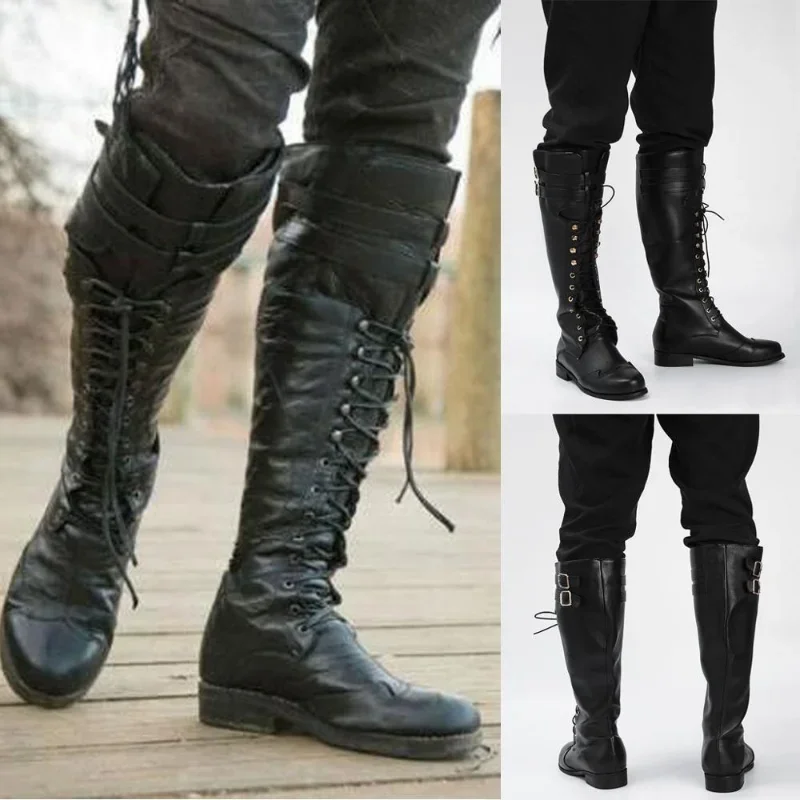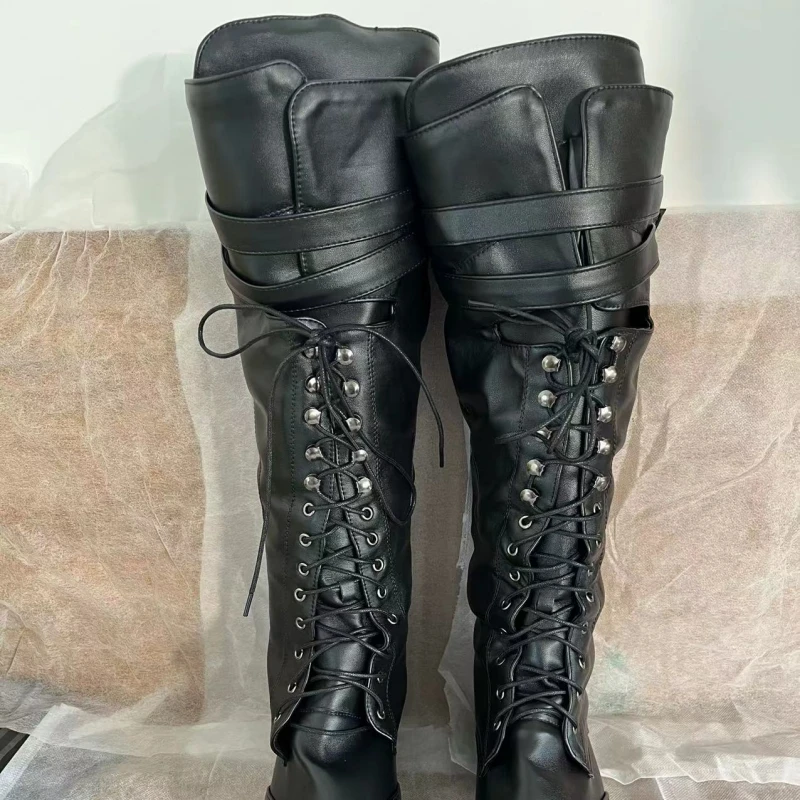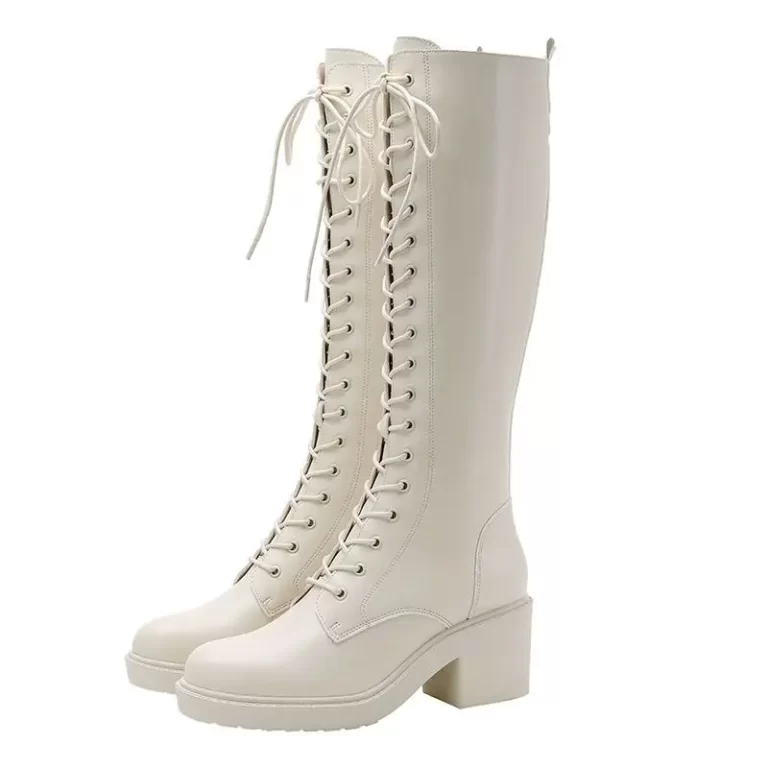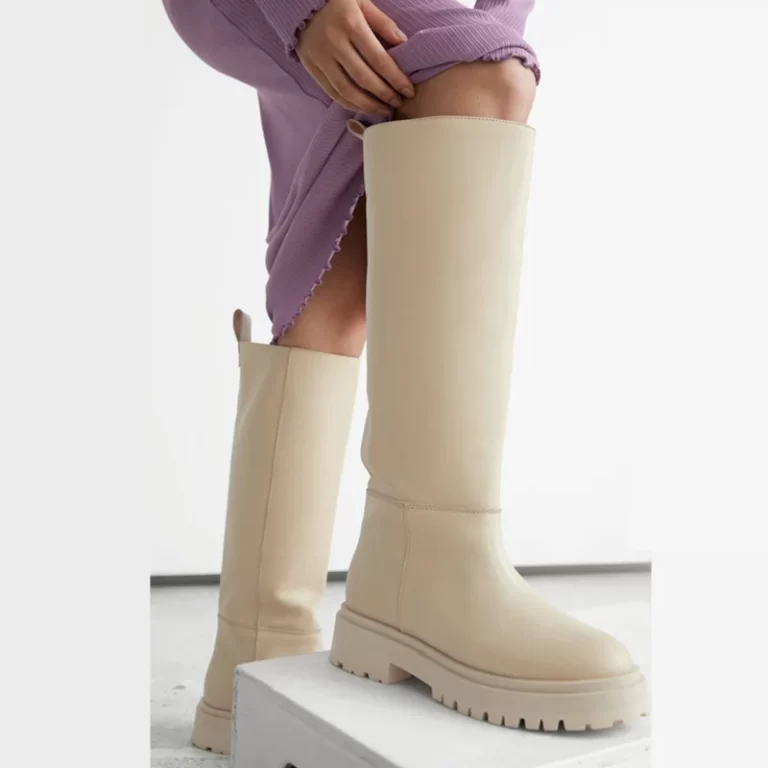Introduction: Why Men’s Knee-High Boots Matter
Men’s knee high boots are not just a practical choice for colder weather; they also offer a distinct style and versatility that can elevate any outfit. These boots are designed to provide extra coverage and protection, making them a staple in both rugged outdoor settings and urban environments. This guide will explore the various aspects of knee-high boots, including their history, design features, types, and how to choose the perfect pair for your needs.

The History of Men’s Knee-High Boots
Early Origins and Historical Significance
The history of knee-high boots dates back centuries. These boots have evolved from practical footwear for soldiers and workers to a fashionable and functional accessory in modern times. Historically, knee-high boots were worn by cavalry soldiers and horsemen. They provided protection and support during battles and long rides. The design of these boots allowed for flexibility and durability, essential for those in active roles. Over time, the practical use of knee-high boots transitioned into various sectors, including fashion.
In medieval times, knee-high boots were also worn by nobility and knights. The design and material used often indicated social status and wealth. Rich fabrics and intricate designs were common among the elite. As time progressed, knee-high boots became popular among different classes. They were not only a symbol of status but also a functional choice for various activities.
The Evolution into Modern Fashion
In the 20th century, knee-high boots began to shift from purely functional footwear to a fashion statement. During the 1960s, knee-high boots gained popularity among women, but they were also embraced by men, especially in certain fashion subcultures. Designers started experimenting with different materials and styles, turning knee-high boots into a versatile fashion accessory. The modern era has seen knee-high boots become a common sight in both casual and formal settings.
Today, knee-high boots are available in various styles, from rugged and utilitarian to sleek and sophisticated. This evolution reflects the changing needs and preferences of wearers, combining both function and fashion. Whether you are looking for durability or style, modern knee-high boots offer something for everyone.
Key Features of Men’s Knee-High Boots
Material Choices: Leather, Suede, and Synthetic
The material of knee-high boots significantly impacts their functionality and style. Leather is a classic choice due to its durability and timeless appeal. It molds to the foot over time, providing a custom fit. Leather boots are known for their ability to withstand harsh weather conditions and are often preferred for their long-lasting qualities. Full-grain leather is particularly sought after for its strength and natural appearance.
Suede is another popular material for knee-high boots. It offers a softer texture compared to leather and has a more casual look. Suede boots are often chosen for their aesthetic appeal and comfort. However, suede requires more maintenance to keep it looking its best. Regular cleaning and protection from moisture are essential to maintain its appearance.
Synthetic materials have become increasingly common in modern knee-high boots. These materials offer a range of benefits, including affordability and ease of maintenance. Synthetic boots can mimic the appearance of leather or suede but are often lighter and more flexible. They are a good option for those seeking a budget-friendly alternative that still offers style and functionality.

Comfort and Support Features
Comfort is a crucial aspect of knee-high boots. Look for features that enhance support and fit. Cushioned insoles and padded collars are common features that add comfort. These elements reduce pressure on the feet and provide extra cushioning, making the boots suitable for extended wear. Arch support is also important, especially for those who spend long hours on their feet.
Boots with adjustable closures, such as laces or buckles, offer a customizable fit. This allows you to adjust the tightness around the calf and ankle, ensuring that the boots stay securely in place. Some knee-high boots also feature breathable linings that help regulate temperature and keep feet dry.
The outsole of the boot plays a significant role in comfort and functionality. Look for boots with well-constructed outsoles that provide good traction and stability. A durable rubber outsole with a tread pattern designed for grip can prevent slipping and provide additional support on various surfaces.
Design and Aesthetic Variations
Men’s knee-high boots come in a range of designs, each catering to different tastes and needs. Classic designs include those with clean lines and minimal embellishments. These boots are versatile and can be paired with both casual and formal attire. They often feature a simple silhouette with a smooth leather or suede finish.
For a more rugged look, consider boots with distressed leather or decorative stitching. These boots are ideal for outdoor activities or casual wear. They often come with additional features such as reinforced toe caps and heavy-duty outsoles, making them suitable for various terrains.
Fashion-forward designs may include unique elements such as buckles, zippers, and patterned materials. These boots add a stylish flair to any outfit and can make a statement in both casual and formal settings. When choosing a design, consider how the boots will complement your wardrobe and personal style.
Types of Men’s Knee-High Boots
1. Work Boots
Durability and Functionality
Work boots are designed for durability and functionality. They often feature reinforced toe caps, steel shanks, and heavy-duty outsoles to withstand tough conditions. These boots are ideal for individuals who work in construction, industrial settings, or any environment where protection is essential.
Work boots come with various safety features such as slip-resistant soles and waterproofing. These features help protect the feet from hazards and keep them dry in wet conditions. The added support and cushioning make work boots suitable for long hours of standing or walking.
Choosing the Right Work Boots
When selecting work boots, consider the specific requirements of your job. Look for boots with safety features that match your needs, such as electrical hazard protection or puncture-resistant soles. Comfort is also crucial, so choose boots with adequate cushioning and support for all-day wear.
Work boots come in various styles, including lace-up and pull-on designs. Lace-up boots offer a customizable fit, while pull-on boots provide convenience and ease of use. Choose the style that best suits your work environment and personal preference.
2. Fashion Boots
Stylish and Trendy Designs
Fashion knee-high boots are designed to make a statement. They come in a range of styles, from sleek and sophisticated to bold and edgy. These boots are often crafted from high-quality materials and feature unique design elements such as decorative buckles, zippers, and patterns.
Fashion boots can be paired with various outfits, including jeans, chinos, and tailored trousers. They add a stylish touch to both casual and formal attire. When selecting fashion boots, consider how they will complement your wardrobe and reflect your personal style.
Choosing the Perfect Fashion Boots
When choosing fashion boots, pay attention to the fit and comfort. Even though style is important, comfort should not be overlooked. Look for boots with a comfortable insole and a good fit around the calf and ankle.
Consider the occasion and purpose of the boots. For everyday wear, choose versatile designs that can be dressed up or down. For special events, opt for boots with unique details that stand out and enhance your outfit.
3. Riding Boots
Features for Equestrian Activities
Riding boots are designed specifically for horseback riding. They feature a tall, sleek design that provides protection and support while riding. These boots often have a smooth, polished finish and are made from high-quality leather for durability.
Riding boots typically include a low heel and a snug fit around the calf to keep the foot securely in the stirrup. They also have a flexible sole that allows for better movement and control. The design helps prevent the foot from slipping and provides stability during rides.
Choosing the Right Riding Boots
When selecting riding boots, ensure they fit properly and provide adequate support. The boots should be comfortable for extended periods of riding and should not restrict movement. Look for features such as reinforced toe caps and padded interiors for added comfort.
Consider the type of riding you will be doing. Different styles of riding may require specific features in your boots, such as a higher heel for jumping or a more flexible sole for dressage. Choose boots that match your riding style and provide the necessary support.

How to Care for Men’s Knee-High Boots
1. Cleaning and Maintenance
Proper care is essential to keep your knee-high boots looking their best and extending their lifespan. Regular cleaning helps remove dirt and prevent damage. For leather boots, use a damp cloth to wipe off dirt and grime. Follow up with a leather cleaner and conditioner to keep the leather supple and prevent cracking.
Suede boots require different care. Use a suede brush to remove dirt and restore the nap of the suede. Avoid using water, as it can damage the material. For stubborn stains, use a suede cleaner designed specifically for this purpose.
Synthetic boots are relatively easy to maintain. Clean them with a damp cloth and mild soap. Avoid using harsh chemicals that can damage the material. Regular cleaning helps keep the boots looking fresh and new.
2. Storage Tips
Proper storage is crucial for maintaining the shape and condition of your knee-high boots. Store them in a cool, dry place away from direct sunlight. Sunlight can cause fading and damage to the materials.
Use boot trees or inserts to help maintain the shape of the boots. These tools prevent creasing and keep the boots looking their best. For tall boots, consider storing them upright to avoid bending and deforming the leather or material.
If you live in a humid environment, use moisture-absorbing products to prevent mold and mildew growth. Keeping your boots dry and well-maintained ensures they remain in good condition for years to come.


